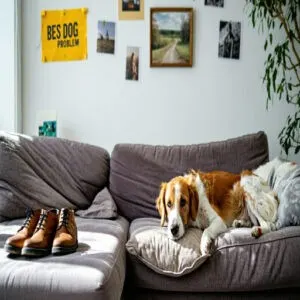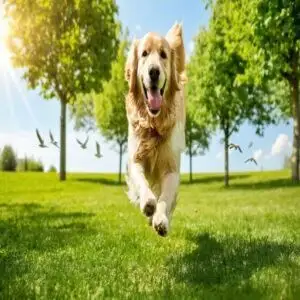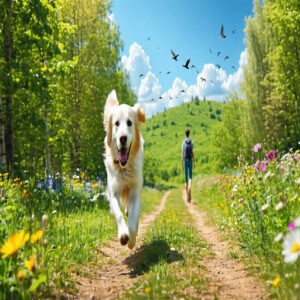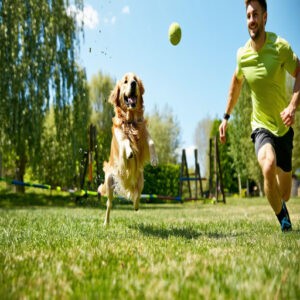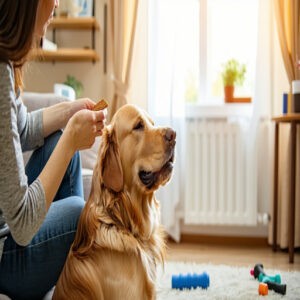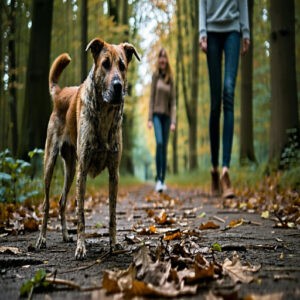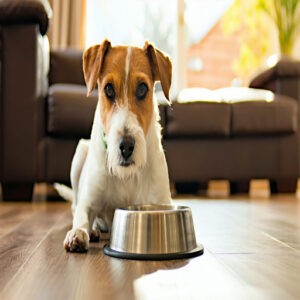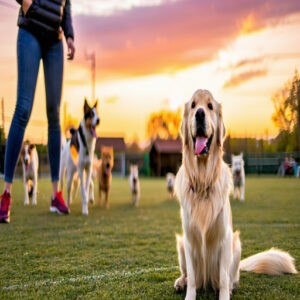This site is supported by our readers. We may earn a commission, at no cost to you, if you purchase through links.
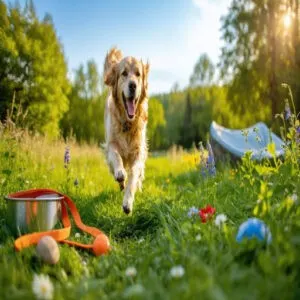 Dog behaviour problems, like barking, chewing, or digging, can leave you scratching your head—and maybe cursing your favorite pair of shoes!
Dog behaviour problems, like barking, chewing, or digging, can leave you scratching your head—and maybe cursing your favorite pair of shoes!
These issues often stem from unmet needs such as exercise, mental stimulation, or consistent training.
Separation anxiety or inappropriate elimination can also point to stress or a lack of routine.
The good news? Many problems are solvable! Consistent walks can work wonders, and chew toys save both furniture and sanity.
Patience and positive reinforcement are your best tools. Understanding your dog’s triggers and communication is key to improving life for both of you.
Ready for happier tails and calmer days?
Table Of Contents
- Key Takeaways
- Dog Behaviour Issues
- Causes of Behaviour Problems
- Solving Behaviour Issues
- Advanced Behavioural Issues
- Preventing Behaviour Problems
- Managing Specific Behaviours
- Frequently Asked Questions (FAQs)
- What are common dog behavior issues?
- How do you know if a dog has behavioural problems?
- Can dogs develop bad behaviors?
- Are you worried about your dog’s behavioural problems?
- What causes bad behavior in dogs?
- What are the most dangerous dog behavior problems?
- Why is my dog suddenly having behavior problems?
- What is the most common behavioral disorder in dogs?
- What is a red flag dog’s behavior?
- How do I help my dog with behavioral issues?
- Conclusion
Key Takeaways
- Identify the root cause of your dog’s behavior problems, like boredom, anxiety, or unmet needs, to effectively address them.
- Use consistent training, positive reinforcement, and patience to tackle issues like excessive barking, chewing, or digging.
- Provide regular exercise and mental stimulation to prevent destructive habits and maintain your dog’s overall well-being.
- Address severe problems like aggression or separation anxiety by consulting a professional and creating a structured plan.
Dog Behaviour Issues
Every dog has quirks, but some behaviors, like constant barking or chewing up your shoes, can become real challenges.
Understanding why these constant barking or peaceful issues happen is the first step to helping your dog and keeping your home peaceful.
Excessive Barking
Curbing excessive barking starts with understanding it’s just your dog’s way of talking.
But when it turns into constant noise pollution, it’s a headache.
- Try Bark Control Methods like teaching “quiet” commands or using sound therapy.
- Address triggers like boredom or anxiety, common sources of dog behavior problems.
- Keep an eye on inconsistent alert systems to pinpoint unnecessary barking.
Destructive Chewing
Destructive chewing can feel like a never-ending battle—damaged furniture, shredded shoes, and excessive gnawing everywhere.
Puppies teething? Try chew toy alternatives like frozen carrots or rubber toys.
For older dogs, tackle stress or boredom with exercise and mental stimulation.
Understanding dog chewing wood habits is essential to addressing the root cause of the behavior.
Chew inhibition techniques, paired with consistent redirection, help curb dog destructive behavior.
Patience and creative Puppy Teething Solutions make all the difference.
Digging Problems
When it’s not chewing, maybe you’re battling yard destruction from dog digging.
Burrowing behavior isn’t just instinct—it’s often about boredom, anxiety, or hunting DNA.
To tackle digging habits, offer more exercise, mental stimulation, or even a designated digging zone.
For hole prevention, try ground reinforcement like chicken wire under soil.
Controlling this dog destructive behavior requires patience and creativity.
Separation Anxiety
Digging holes may frustrate you, but they rarely compare to the heartbreak of dog separation anxiety.
Lonely dogs feel extreme stress from owner absence, leading to barking, destruction, or accidents within minutes.
Anxiety triggers, like routine changes, amplify canine stress, and combat pet separation with gradual departures, engaging toys, and consistent calming cues to ease your dog’s anxiety and restore balance.
Inappropriate Elimination
Inappropriate elimination, like accidental soiling or urine marking, can stem from dog house training issues, medical causes, or separation anxiety.
For house soiling, consistent housebreaking tips like scheduled potty breaks and rewards work wonders, considering a litter box for small breeds or crate training.
Patience and addressing deeper dog behavior problems are key to long-term success, after first ruling out health problems.
Causes of Behaviour Problems
Behavior problems in dogs often stem from unmet needs like exercise, mental stimulation, or consistent training.
Sometimes it’s just their way of telling you they’re bored, anxious, or overwhelmed.
Benefits Of Regular Exercise
Regular exercise does wonders for dog wellness and helps address dog behavior problems.
From chewing to barking, daily activity keeps your pup balanced. Plus, it boosts physical health and mental wellness with these perks:
Engaging in dog exercise routines is essential for their overall health.
- Tackles obesity and strengthens joints.
- Reduces anxiety and boredom.
- Improves canine fitness and heart health.
- Promotes better obedience training.
- Supports effective dog behavior modification.
Effective Workout Routines Today
Looking for solutions to dog behavior problems? Start with effective workout routines.
Walking, jogging, or hiking builds physical conditioning and supports your dog’s healthy lifestyle.
Keep things fresh—switch up your exercise routines for mental stimulation.
To learn more about how to exercise your dog effectively, consider combining physical activities with mental stimulation techniques.
Here’s a quick guide to fitness planning:
| Activity | Benefits | Tips | Best For |
|---|---|---|---|
| Walking | Low impact, calming | Add sniff breaks | All dogs |
| Jogging | High-energy outlet | Use hands-free leash | Active breeds |
| Hiking | Muscle-building, scenic | Start with short trails | Adventurous pups |
| Swimming | Joint-friendly exercise | Supervise with a life vest | Senior dogs or injured |
Staying Motivated To Exercise
It’s easy to lose steam with your exercise routine, but sticking to fitness goals isn’t just about you—it’s for your dog too.
Make daily activity fun by mixing up workout plans with games like fetch or agility drills.
Motivation tips like setting small goals or involving friends can inspire consistency, you’ll see improved canine behavior through better dog training techniques!
Solving Behaviour Issues
In the matter of solving your dog’s behavior problems, patience and consistency are your best tools.
By focusing on training, understanding the cause, and reinforcing good habits, you can help your dog thrive.
Training and Socialization
Helping your dog behave better starts with puppy obedience and solid dog training.
Puppy socialization teaches them to handle life calmly and confidently.
Effective use of dog training tools can substantially enhance the learning process.
Try these:
- Expose to diverse sights, sounds, and smells early.
- Use rewards for good canine communication.
- Guide with short, simple cues.
- Study their dog body language.
- Build trust while fostering fun pack dynamics.
Addressing Underlying Causes
Understanding dog behavior problems often comes down to spotting emotional triggers and stress signals.
Anxiety factors or fear-based behaviors can drive unwanted actions like chewing or barking.
Use behavior modification to address root causes, not just symptoms.
| Problem | Possible Cause | Stress Signal | Action Plan |
|---|---|---|---|
| Barking | Anxiety | Pacing, whining | Teach "Quiet" command |
| Chewing | Boredom | Restlessness | Offer chew toys, exercise |
| Digging | Energy surplus | Hyperactivity | Increase outdoor play |
| Inappropriate Elimination | Stress, fear | Avoiding certain areas | Vet check, housetraining |
Management Techniques
Once you’ve pinpointed the root cause, managing dog behavior problems effectively hinges on a solid plan.
Behavior correction guarantees your pup stays on track. Utilizing dog training aids can greatly support this process.
Try these strategies:
- Create structure: Crate training or designated spaces help with dog behavior management.
- Redirect focus: Chew toys or puzzles can prevent bad habits.
- Stay consistent: Align your behavior modification techniques with patience and routine.
Positive Reinforcement
Swapping frustration for progress? Reward-based training is your answer.
Positive reinforcement builds trust and focus in obedience training.
Treat motivation works wonders, but pair it with praise techniques and clicker training for better impact.
Consistency matters—dogs thrive on routine when tackling canine behavior modification.
Here’s a breakdown:
| Method | Example | Why It Works |
|---|---|---|
| Treat Motivation | Small snack rewards | Encourages desired behavior |
| Praise Techniques | Verbal “Good boy!” |
Advanced Behavioural Issues
When your dog’s behavior goes beyond basic training challenges, issues like aggression, fear, or resource guarding can feel overwhelming.
With the right knowledge and tools, you can address these problems effectively and help your dog feel more secure.
Aggression in Dogs
Spotting dog aggression early—like territorial aggression or fear aggression—can save headaches (and bites).
Signs like stiff posture or growling hint trouble brewing. Prevent fights by reading body language or avoiding triggers.
Bite inhibition, consistent training, and rewards teach restraint. Even aggressive breeds can learn control, but for canine attacks or severe possessive aggression, calling a pro builds safety and trust, through consistent training.
Fear and Anxiety
Fear and anxiety can make your dog’s world feel overwhelming, but with the right approach, you can help, recognizing fear responses and applying calming techniques customized to their anxiety triggers.
Focus on stress management and gradual desensitization to ease fear-based behaviors like phobia or fear aggression, this is a crucial step in helping your dog.
- Stay patient and calm.
- Introduce triggers gradually.
- Avoid punishment.
- Use positive reinforcement.
- Consult a veterinarian.
Resource Guarding
Resource guarding is a tricky behavior where dogs fiercely protect food, toys, or even random objects.
This possessive aggression stems from survival instincts but can escalate if ignored.
Understanding dog training aggression is essential in addressing such issues.
Teach "trade" commands, use positive reinforcement, and never punish resource defense—it worsens possessive behavior.
For severe dog resource guarding or canine aggression, work with a trainer to restore calm and control.
Preventing Behaviour Problems
Preventing behavior problems starts with setting your dog up for success through training, socialization, and consistent routines.
When you provide plenty of exercise, mental stimulation, and clear guidance, you’ll help your dog develop good habits and avoid trouble through socialization.
Early Training and Socialization
Tackling advanced dog behavior problems begins early.
Social learning during puppyhood lays the foundation for good habits. Effective use of Dog Training equipment can also aid in the process.
To prevent issues like fear or aggression:
- Expose your puppy to new sights, sounds, and people calmly.
- Use positive reinforcement to instill basic manners.
- Focus on obedience training daily.
- Encourage healthy canine communication through play with other dogs.
Providing Adequate Exercise
A well-exercised dog is a happy dog.
Meeting your pup’s exercise needs—whether it’s outdoor fun like fetch or a brisk walk—helps burn energy and curb destructive behavior.
Skipping playtime can lead to hyperactivity or dog behavior problems.
Match activities to their fitness levels, and you’ll see improvements in dog obedience and overall temperament.
Exercise isn’t optional—it’s essential!
Mental Stimulation and Enrichment
Keeping your dog mentally sharp is as essential as exercise.
Sensory play like snuffle mats or bubble games taps into canine psychology.
Brain games such as the muffin tin treat challenge or scavenger hunts boost cognitive training.
Environmental enrichment with interactive toys and scent games prevents dog behavior problems.
Pair these with positive reinforcement for a happy, engaged pup!
Managing Specific Behaviours
When your dog’s barking, chewing, or leash pulling becomes a challenge, managing these specific behaviors can feel overwhelming.
With the right strategies and some patience, you can address these issues and create a more peaceful routine for both of you.
Barking and Whining
Does your dog’s barking and whining leave you frazzled? Understanding canine communication is key!
Train with a "quiet" cue and use high-value treats. Try this for Bark Control and Whine Reduction:
- Block triggers (like passersby).
- Provide puzzle toys.
- Ignore attention-seeking noises.
- Reward quiet moments.
Effective dog barking control methods can also help minimize excessive barking by addressing the root causes of the behavior.
Prevent noise pollution while keeping harmony at home—you’ve got this!
Chewing and Digging
After barking comes chewing and digging—behaviors that turn your home or yard into their playground.
Destructive chewing? Try chew toy options to redirect them. For digging deterrents, block soil attractions or gift them a “buried treasure” spot.
Exercise curbs that restless energy fueling destruction. Destruction prevention blends distractions with clear boundaries; patience turns these dog behavior problems into manageable habits.
Jumping and Begging
Jumping habits and begging for food can mess with your canine etiquette plans.
To manage these dog behavior problems, follow these steps:
- Discourage jumping up by turning away and ignoring.
- Teach “off” or “sit” commands as alternatives.
- Fix food begging by enforcing table manners—no scraps!
- Positive reinforcement works—reward calm behaviors.
Stay consistent!
Leash Pulling and Hyperactivity
Tired of your arm getting yanked during walks?
Leash pulling happens because dogs want to explore. Stop moving when the leash tightens; only resume when it’s loose. Using a front-attaching harness works wonders too.
For hyperactive dogs, focus on structured routines, plenty of exercise, and mental challenges—overexcitement fades when you meet their exercise needs.
Frequently Asked Questions (FAQs)
What are common dog behavior issues?
Did you know about 50% of dog owners struggle with behavioral issues?
Common problems include excessive barking, chewing, digging, separation anxiety, and house-soiling.
These challenges often stem from boredom, anxiety, or lack of proper training.
How do you know if a dog has behavioural problems?
You’ll notice behavioral problems if your dog barks excessively, chews destructively, eliminates indoors, or acts anxious when you’re away.
Watch for aggression, digging, or fear-based reactions—these often signal deeper training or health issues, and can be associated with behavioral problems.
Can dogs develop bad behaviors?
Like weeds in a garden, bad behaviors can sprout in dogs if their needs aren’t met.
Boredom, anxiety, or inconsistent training often cause issues like excessive barking, chewing, or aggression.
Structured routines solve wonders!
Are you worried about your dog’s behavioural problems?
It’s normal to feel overwhelmed by your dog’s behavior.
Whether it’s endless barking or chewed-up shoes, you’re not alone.
Understanding the causes and using consistent training can bring the peace you’re craving.
What causes bad behavior in dogs?
Bad behavior in dogs often stems from boredom, anxiety, lack of training, or unmet needs.
They might chew, bark, or dig excessively to release energy or cope with stress—it’s their way of communicating something’s off.
What are the most dangerous dog behavior problems?
Aggression, biting, and uncontrollable fear-related behavior are the most dangerous dog issues.
They can harm others, yourself, or your pet.
Recognizing triggers early and involving a canine behaviorist guarantees safety for everyone involved.
Why is my dog suddenly having behavior problems?
Your dog’s sudden behavior changes could stem from stress, boredom, medical issues, or disruptions in routine.
Check for recent changes at home, health concerns, or unmet needs.
Consult your vet if the behavior persists.
What is the most common behavioral disorder in dogs?
Did you know over 20% of dogs struggle with separation anxiety?
This common issue shows up as barking, destructive chewing, or accidents when you leave.
With training and patience, though, your pup can feel secure again.
What is a red flag dog’s behavior?
A red flag in a dog’s behavior might be sudden aggression, fearfulness, or excessive anxiety.
If your usually calm dog suddenly growls, snaps, or acts overly scared, it’s time to dig deeper or consult a professional.
How do I help my dog with behavioral issues?
Helping your dog with behavioral issues is like learning their secret language.
Start with consistency, reward good behavior, and redirect bad habits.
Patience, positive reinforcement, and consulting a professional trainer can make a huge difference.
Conclusion
Tackling dog behaviour problems takes patience, consistency, and understanding your dog’s needs.
Whether it’s excessive barking, chewing, or separation anxiety, many issues stem from unmet physical or mental stimulation.
A solid routine with regular walks, training, and enrichment activities can make all the difference.
Don’t overlook early socialization and positive reinforcement—they build confidence and trust.
With effort, you’ll see progress, happier tails, and a stronger bond.
Your dog isn’t just learning—you’re growing together too.
- https://www.aspca.org/pet-care/dog-care/common-dog-behavior-issues
- https://topdogtips.com/most-common-dog-behavior-problems/
- https://www.thesprucepets.com/common-dog-behavior-problems-1118278
- https://www.msdvetmanual.com/behavior/normal-social-behavior-and-behavioral-problems-of-domestic-animals/behavioral-problems-of-dogs
- https://www.instinctdogtraining.com/learn/

